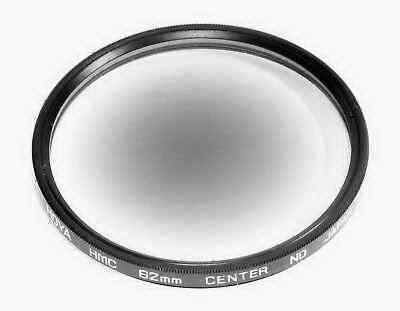

Many shutterbugs think that CND filters are only used on large format cameras -- whatever "large format" means. While this is generally true, it does not mean that the users of smaller formats -- whatever "smaller" means -- don't have to worry about light fall-off, and cannot benefit from the use of CND filters. It depends on the lens.
Further, some "experts" recommend only considering using CND filters with lenses with angles of coverage greater than 90°. That's basically lenses wider than 24mm for 35mm cameras, 40mm on 6x6 cameras, and 90mm for 4x5 cameras. Again, it depends on the lens. For example, Carl Zeiss Jena made a CND filter specifically for their large format 150mm f8 APO-Germinar W lens which has an angle of coverage of 63° -- the coverage of a typical 35mm lens in the 35mm format, 55mm in 6x6 format, or 125mm in 4x5 format. They would not have made these expensive CND filters if they did not think they were beneficial.
But it is all up to you to decide!
Here are three lenses, all with the same 100° angle of coverage. On the right is an 18mm lens for 35mm work, the next is a 64mm lens for a 4x5" camera, and on the left is a 133mm lens for the 8x10" format.
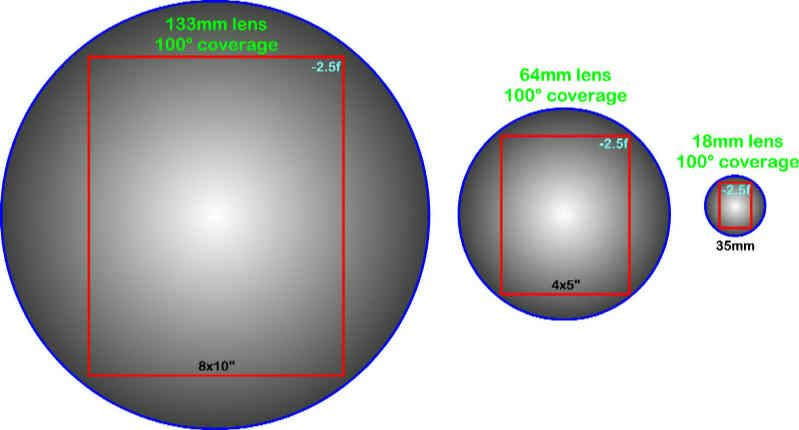
As you can see, because they all have the same angle of coverage, they all
have the same light fall-off on the edge. But despite the fact that most
CND filters were designed with large format users in mind, the fact that
they are used on wide-angle lenses, and that the filter threads for wide-angle
lenses of any format are very similar, there is no obstacle to the use of
CND filters on medium format and even smaller format cameras -- other than
finding the right CND filter for your lens.
Whether any of YOUR lenses could benefit from CND filters depends on several factors. The first, and most important, is the structure of your lens. Only rectilinear lenses are impacted by light fall-off by the "Cosine4 Law". Fisheye lenses are not, due to their unique optical design. And not all rectilinear lenses are impacted to the same degree. Some have optical designs that minimize the affect -- but these designs don't necessarily remove it completely. One common design in wide-angle lenses are "retro-focus lenses", some incorporating "floating elements". While more expensive to make -- due in part to the addition of extra elements -- these designs are especially important in wide-angle lenses on SLR cameras, in order to keep the rear of the lens far enough away from the reflex mirror. Most large format cameras are not an SLR design, and lack mirrors, so most large format lenses have no need for these optical "refinements" -- thankfully, as they are expensive enough.
The wider the angle of coverage of your lens(es) -- no matter what format -- the more likely you can benefit from using an appropriate CND filter. Here is a 12mm rectilinear lens with a 120° angle of coverage on a 35mm SLR.
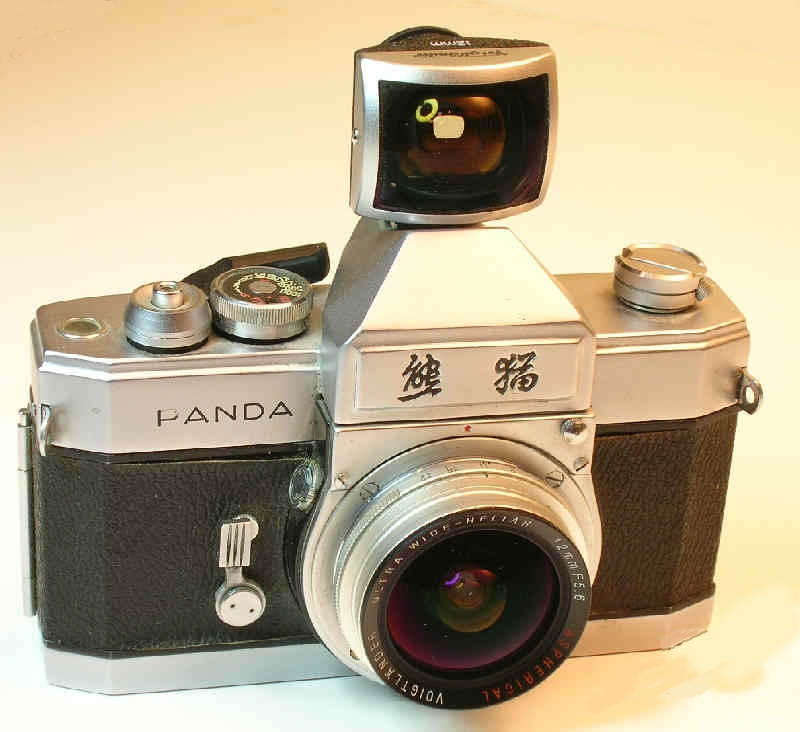
The light fall-off on the edges is about 90% -- more than three f-stops. This is not a retro-focus-designed lens -- that's what keeps it relatively affordable -- and it benefits tremendously from a CND filter, even though it is a lens designed for 35mm work. The rear of the lens sits so close to the film that the lens can only be used on SLR cameras with a mirror lock-up setting -- and a special, add-on viewfinder. There are other, similar "35mm" lenses, from 10mm to 21mm that benefit from CND filters.
In short, if you use wide-angle lenses that have wide enough angles of coverage -- using the graph above -- you ought to run some simple tests to see if your lens(es) suffers from light fall-off. Just take pictures of a clear blue sky -- with your lens(es) set at infinity and at FULL aperture, and then look at the corners of the printed picture -- NOT just the groundglass. Pretty simple. If the corners are darker than the center -- or darker than you would like them to be -- you might want to consider a CND filter.
Some lens manufacturers, notably Schneider-Kreuznach and Rodenstock, have made CND filters for specific lenses. But even here, you might prefer a different CND filter than they suggest. And with other lens manufacturers, such as Nikon and Fuji, you are on your own.
Typically when people look for a CND filter for their len(es), they look at the angle of coverage of the lens. While this might seem to be the best place to start, it is more important to look at the picture angle of the lens -- and the format of the film/sensor. This is what determines what the actual light fall-off to the image will be -- which helps you determine which CND filter is best to use. There can be a BIG difference between the angle of coverage and the picture angle, so let's set some definitions:
You'll hear a lot of terms thrown around in the discussion of CND filters. Some of these terms mean exactly the same thing, some are somewhat different, and some are completely different. Unfortunately, sometimes people use the same term when referring to different things, and sometimes people use different terms while discussing the same thing. All of this can end up in complete confusion.
Angle of Coverage
(AOC) -- The Angle of Coverage (AKA, Covering
Power) of a lens is listed in degrees, and typically determined with the
lens set at f22. It is often confused with the picture angle or angle of
view because they are both angles. The Angle of Coverage determines how wide
the image circle will be. The angle of coverage does NOT change as you focus
away from infinity.
Image Circle --
The Image Circle is listed in millimeters or inches, and typically determined
at f22. It is often confused with the Picture Size. The image circle determines
which film formats can be used with the lens. The larger the image circle,
the larger the picture size it can cover. To use a lens, and to have it
completely cover the film, the lens has to have an image circle with a diameter
as large, or larger, than the hypotenuse of the film format. For example,
you'll need an image circle greater than 155mm to cover the hypotenuse of
the image on 4x5 film -- 6.1" (155mm) -- depending slightly on your film
holders. The image circle INCREASES as you focus away from infinity.
Picture Size --
The Picture Size is also listed in millimeters or inches. It is often confused
with the Image Circle. Most shutterbugs consider this the hypotenuse of the
film format, but others prefer the long side of the film, or some other
convoluted formula. The picture size does NOT change as you focus away from
infinity, but it does determine the picture angle.
Picture Angle
-- The Picture Angle (AKA, Angle of View, Picture
View) is listed in degrees at infinity. It is often confused with the Angle
of Coverage (or Covering Power) because they are both angles. While this
is commonly listed for smaller roll film formats, such as 84° for a
24mm wide-angle lens on 35mm film, it is not listed for cameras capable of
using different film sizes -- most notably medium and large format cameras.
The Picture Angle DECREASES as you focus away from infinity.
(Field of View (FOV) and Lens Perspective are other, often-seen terms that can mean anything from the Angle of Coverage to the Picture Angle -- and will not be used here!)
Relationship of Angle of Coverage, Image Circle, Picture Size, and Picture Angle
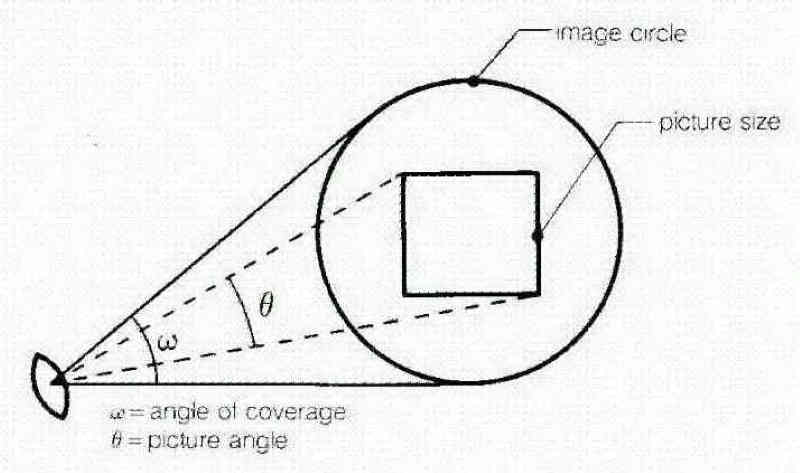
Here is a 133mm lens, with a 100° angle of coverage, with three different
film formats.
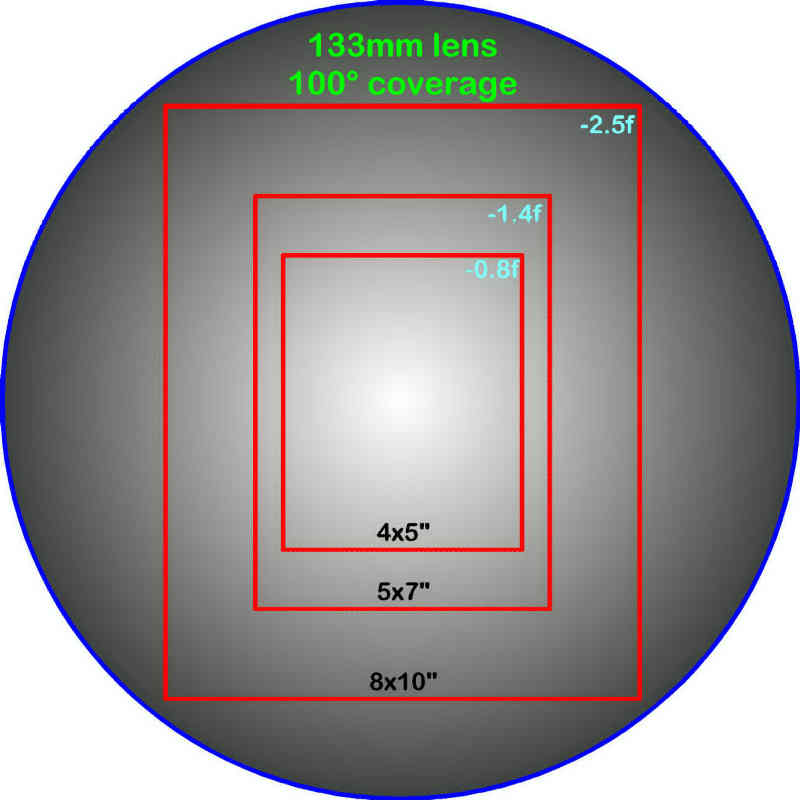
Note that the light fall-off decreases substantially as the film format decreases in size. So in this example, the exact same lens does not need a CND filter for 4x5 use, but definitely needs one for 8x10 use. IN THIS EXAMPLE, if you use a CND filter designed for a lens with a 100° angle of coverage, your CND filter effect will be too strong for formats smaller than 8x10" -- AND you'll be wasting a lot of money.
However, if you use a CND filter designed for the picture angle of the lens and format -- INSTEAD OF THE ANGLE OF COVERAGE OF THE LENS -- the correction will work. When deciding if you need a CND filter, and which one, the important factor is the PICTURE ANGLE and NOT the ANGLE OF COVERAGE. Here are a Fujinon 120mm and a Schneider 120mm. When, using 4x5 film, there is almost a one f-stop drop in light in the corners -- with BOTH lenses. Using the Angle of Coverage for the Fujinon (100°) -- Schneider made a similar lens -- you would think you need a strong CND filter, but using the Picture Angle paints a much different picture, and is the same for BOTH lenses:
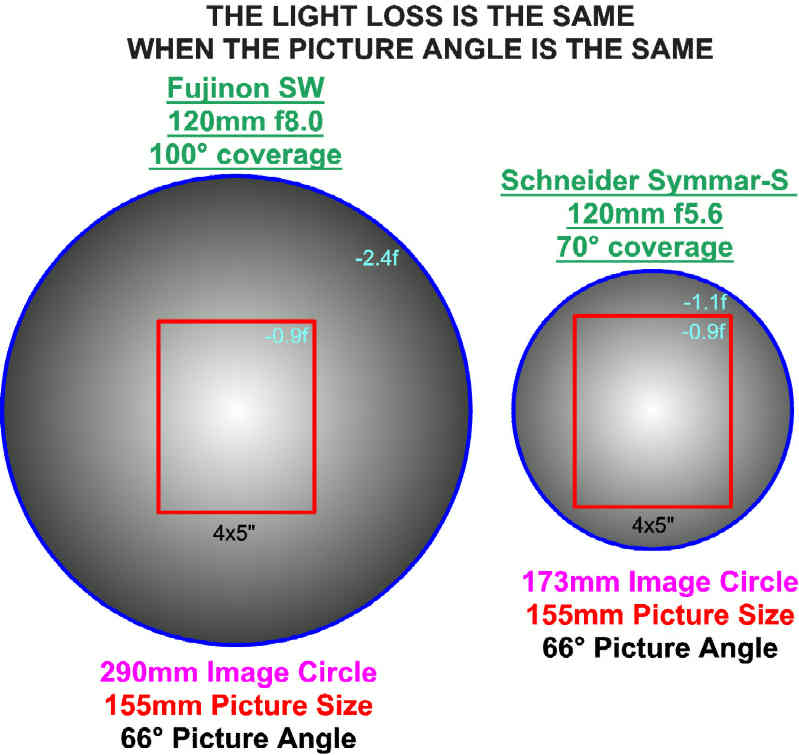
So how do you determine the picture angle? For most fixed format cameras, such as most 35mm cameras, this is typically listed by the lens manufacturer, such as 84° for a 24mm lens, or 104° for a 17mm lens, etc. The same is somewhat true of medium format cameras -- but plenty of these have adjustable, switchable formats, such as 6x45cm to 6x6cm to 6x7cm. When the format is changed, the picture angle changes -- using the same lens! Similarly, with larger format cameras, the picture angle can change because most large format cameras can be used with various film formats, such as 4x5" AND 6x9cm.
In order to determine the Picture Angle you need to know the optical focal length of the lens AND the Picture Size (which you determine from the film format being used). Here is the formula:
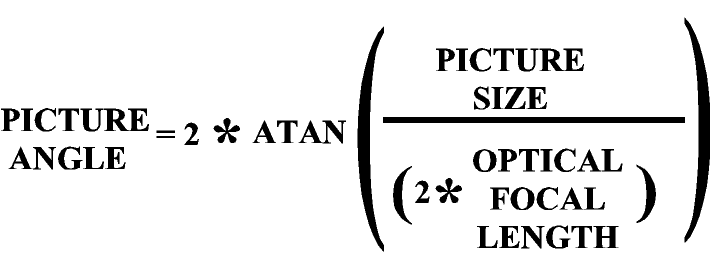
The picture size is determined by you. Most people prefer the diagonal of the image on the film. For 35mm, it is 43mm. For my 4x5 work, my Mido holders produce a diagonal of 155mm. But that is up to you. You may want to increase the Picture Size if you plan on substantial movement (AKA Shift & Rise/Fall). Simply add the amount of movement you expect to need onto the picture size. But remember to check the Image Circle of the lens to determine the maximum amount of movement you can make, as well as the physical limitations of the camera. With all wide angle lenses there is very little room between the lens and the film. The ability to move the lens in any direction will be small -- but that is easy to determine with your camera(s) and lens(es).
Here is a graph showing the Picture Angle -- the factor determining YOUR light fall-off -- by the lens focal length AND the film format. If you have a different film format, you can use the above formula to create your own graph.
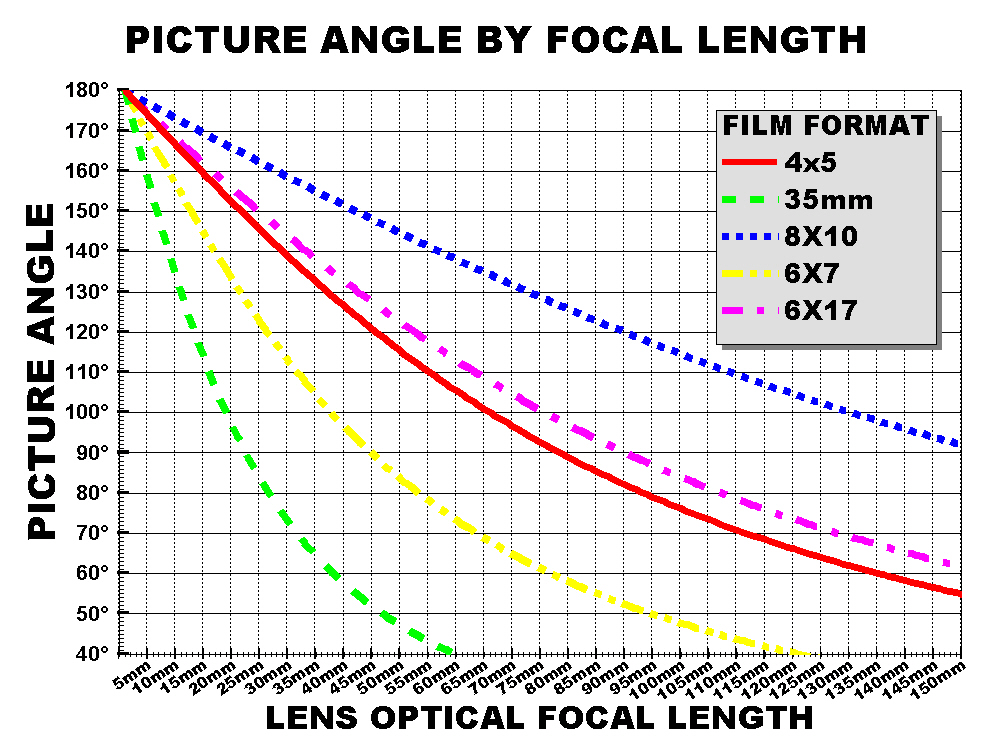
With the focal length of the lens, and the picture size, the picture angle is easy to determine -- but if you use many spreadsheet programs for your calculations, such as EXCEL or OPEN OFFICE, you have to add "DEGREES" in front of the "ARCTANGENT" (AKA "ATAN") part of the formula.
If your simple test(s) -- above -- determines that you can benefit from a CND filter, the above formula can help you determine which CND filter is best you. Choose one that is the right filter size and density (determined with this formula) for your needs.
Now that the PICTURE ANGLE is determined, the amount of light loss at each angle can be plugged in -- regardless of your film format. These results can replace the numbers from the earlier graph -- Light Loss based on the ANGLE OF COVERAGE. Now just look up your picture angle (from the above graph or formula), and you can tell the density of the CND filter you need (from the below graph).
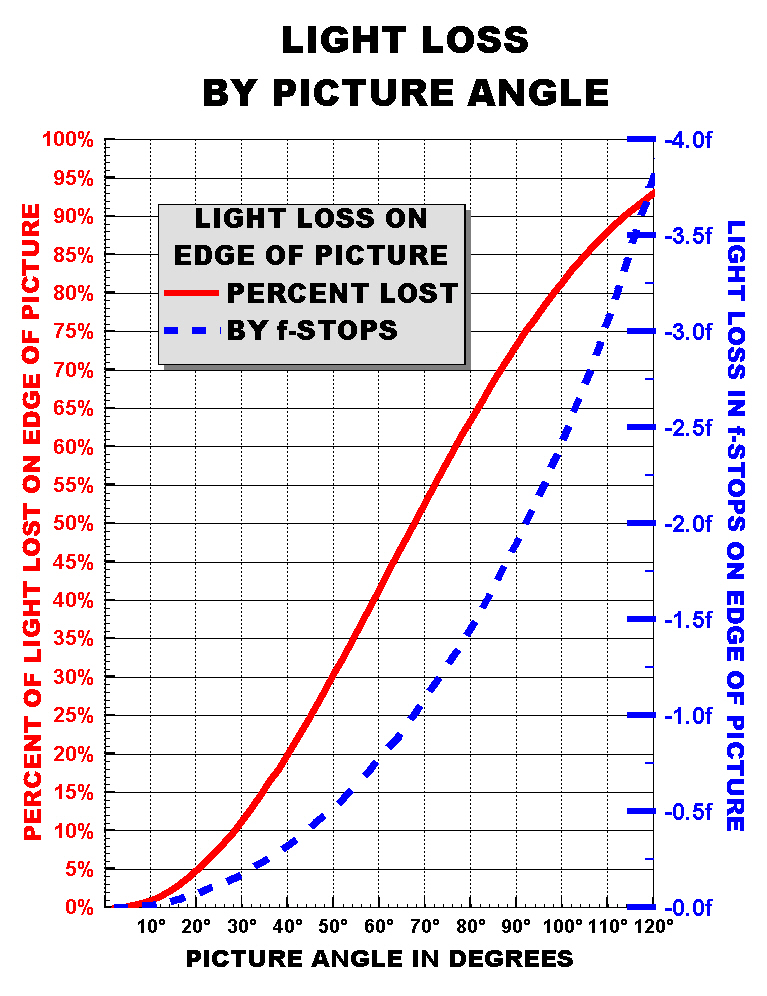
https://kenrockwell.com/tech/center-filters.htm#cure
COPYRIGHT@1995-2019 by Joe McGloin.
All Rights Reserved.
The material on this website is protected by US Federal copyright laws and
cannot be copied or used in any manner without specific approval from the
owner.